The 5th IEEE MTT-S DMI Workshop
Date: 20 Oct 2023 EDT 3pm – 5pm
Regions: 1-7&9
Venue: WebEx and countries in Europe.
DMI Speakers: Prof. Rhonda Franklin, Prof. Jasmin Grosinger, Prof. and Prof. Ke Wu

The scope of the talks:
The DMIs introduced the history of microwave and radio frequency technologies, the evolution of modern microwave systems, and the cutting-edge wireless applications yet to be used in our daily lives in the foreseeable future. The DMIs presented the long journey of wireless technologies from traditional applications 30 years ago (radio, TV and analog mobile phone) to today’s portable devices and wearable/implantable wireless sensors, all relying on microwave technologies. The DMIs discussed three topics in this workshop: Radio Frequency Designs for Sustainability, Electronics in Extreme Frequencies and Electromagnetics for Healthcare.
Attendance (on campus):
University of Central Florida:
- Jasmin Grosinger attended in person
- Local Host: Prof. Xun Gong
- The number of students in classroom: 90
University of Alabama:
- Local Host: Nathan Jeong
- The number of students in classroom: 49
ITESO – The Jesuit University of Guadalajara, Mexico:
- Local Host: José Ernesto Rayas-Sanchez,
- The number of students in classroom: 22
The University of Texas Dallas:
- Local Host: Rashaunda Henderson,
- The number of students in classroom: Approx.10
Attendance (online): 68
Total estimated attendees: 171
Survey by attendees:
- Joseph Tuckerman: I found the workshop to be incredibly interesting and informative.
- Blaise Tshibangu: perfect y interesting.
- Nolan Light: Good workshop except the technical difficulties
DMI Organising Committee:
Xun Gong, Nathan Jeong, José Ernesto Rayas-Sanchez, Yang Yang, Miguel Laso, Rashaunda Henderson
Regions 1-7&9 Ambassadors: See Appendix 2
Agenda:
2:30 pm – 3:00 pm – Workshop Preparation. The DMIs, ambassadors and moderators (faculty members) log in to the Webex system. Arrange the students to settle down in the classrooms.
3:00 pm – 3:05 pm – Opening – Brief introduction to DMI program, (approximately 3 min) by Xun Gong (Host), Nathan Jeong (Co-Host), Rashaunda Henderson(Co-Host), Jose Ernesto Rayas-Sanchez (Co-Host), Miguel Laso (Co-Host) and Yang Yang (Co-Host) .
3:05 pm – 3:25 pm (about 20 min) – Presentation by Prof. Rhonda Franklin (University of Minnesota)
3:25 pm – 3:45 pm (about 20 min) – Presentation by Prof. Jasmin Grosinger (Graz University of Technology)
3:45 pm – 4:05 pm (about 20 min) – Presentation by Prof. Ke Wu (Polytechnique Montréal)
4:05 pm – 4:45 pm (about 30 min – 40 min) – Q & A in (questions posted in Chat window)
4:45 pm – 5:00 pm Closing (Photo taken for all through Webex) by Yang Yang and other co-hosts
The moment:
- The Talk by Rhonda Franklin
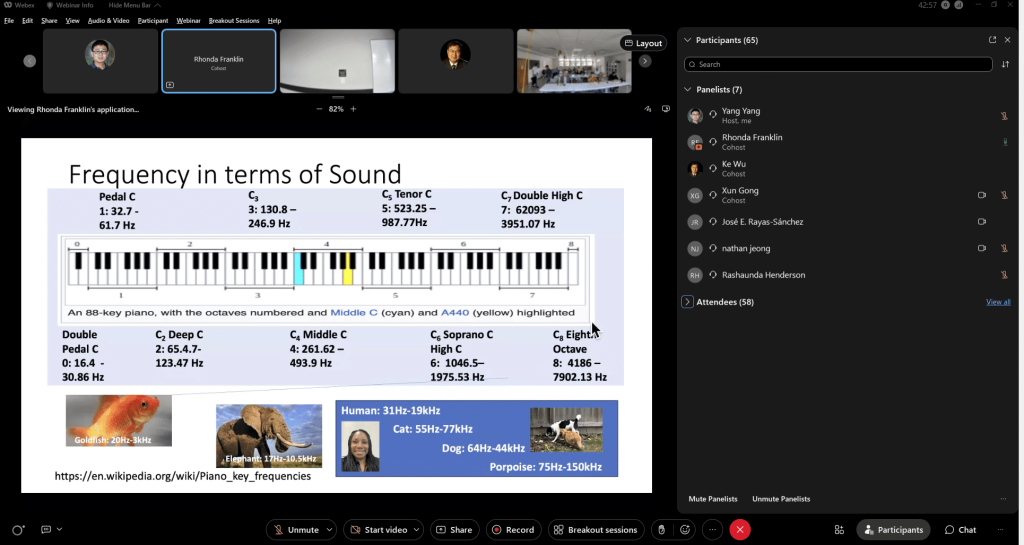
- The Talk by Jasmin Grosinger:

- The Talk by Ke Wu:

- Q&A session:

Appendix 1 – Students in DMI Workshops
At the University of Central Florida:

At the University of Alabama:

At ITESO – The Jesuit University of Guadalajara, Mexico:
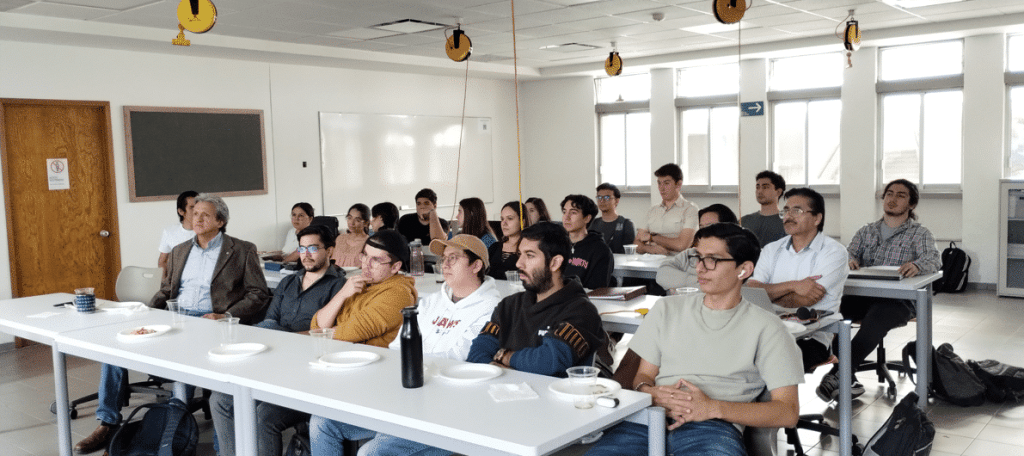
At The University of Texas Dallas:
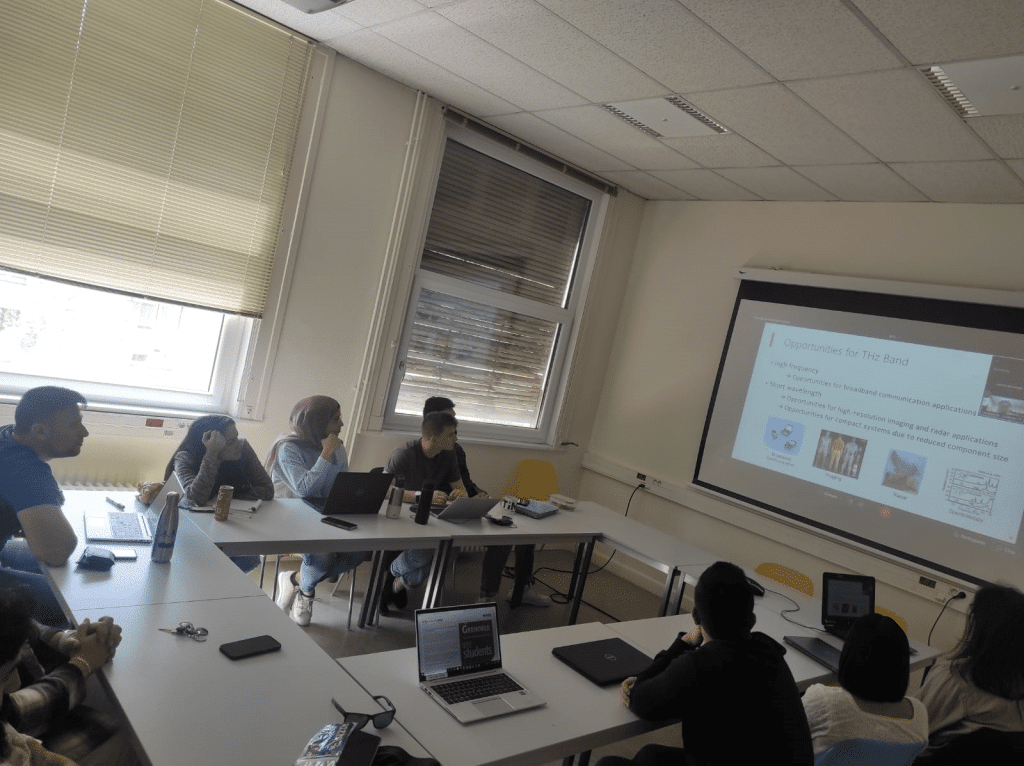
Appendix 2: Acknowledgement of the Ambassadors
| Country | City | University | Professor Name |
| Argentina | Buenos Aires | Universidad Nacional de La Plata | Ramón López La Valle |
| Brazil | Vitória da Conquista | IFBA – Federal Institute of Bahia | Kenedy Marconi |
| Brazil | Campina Grande | UFCG | Glauco Fontgalland |
| Brazil | Recife | UFPE – Federal University of Pernambuco | Marcos Tavares de Melo |
| Brazil | Canoas | IFRS | Claudio Fernandez Rodriguez |
| Chile | Valparaiso | Pontificia Universidad Catolica de Valparaiso | Francisco Pizarro |
| Mexico | Ensenada | CICESE | Carmen Maya-Sánchez |
| Mexico | Guadalajara | ITESO – The Jesuit University of Guadalajara | Jose Rayas-Sanchez |
| Mexico | Puebla | INAOE | Roberto S. Murphy |
| Peru | Arequipa | UNSA | Eliot Rosado-Velasquez |
| USA | Tuscaloosa | University of Alabama | Nathan Jeong |
| USA | Florida | UCF | Sonali Das |
| USA | Dallas | UTD | Rashaunda Henderson |
The 4th IEEE MTT-S DMI Workshop
Date: 10 March 2023 (10am – 12pm IST)
IEEE Region: 10
Venue: WebEx and multiple campus in India, China and other Region 10 countries.
DMI Speakers: Prof. Jae-Sung Rieh, Prof. Shiban Koul and Prof. Quan Xue

The scope of the talks:
The DMIs introduced the history of microwave and radio frequency technologies, the evolution of modern microwave systems, and the cutting-edge wireless applications yet to be used in our daily lives in the foreseeable future. The DMIs presented the long journey of wireless technologies from traditional applications 30 years ago (radio, TV and analog mobile phone) to today’s portable devices and wearable/implantable wireless sensors, all relying on microwave technologies. The evolution of microwave engineering and its applications to 5G/6G wireless communications, virtual reality, telepresence and automotive radar in unmanned vehicles are also discussed in the workshop by the DMIs.
Attendance:
- India:
- The total classroom attendance from Hyderabad/Vizag region was 329 and around 30 students/faculty members joined online.
- Vardhaman College of Engineering, Sahmshabad, Hyderabad (Faculty advisor Dr. Sulakshana Chilukuri)- Classroom mode
- Matrusri Engineering College, Saidabad, Hyderabad-(Faculty advisor Dr. M. Naresh)- Classroom mode
- QIS College of Engineering & TEchnology, Ongole, A.P.-(Faculty advisor Dr. Prasad Jones)- Classroom mode
- Stanley College of Engineering for Women, Hyderabad- (Coordinator-Dr. K.N Sahu)-Classroom mode
- National Institute of Technology, Warangal, Telangana-(Faculty Advisors: Dr. G. Arun Kumar/Dr. Gopi Ram)
- L University, Vijayawada, Telangana (Faculty Advisor: Dr. Arjuna Mudulli)-virtual mode
- MJ College of Engineering and technology, Hyderabad (Faculty Advisor-Dr. Ayesha Naaz)-virtual mode
- BVRaju Institute of Technology, Narasapur Hyderabad (Faculty Advisor-Dr. B. Sanjeeva Reddy)
- Raghu Institute of Technology, Vizag, A.P. (Faculty advisor Dr. Sameer Chakravarti)
- North India(Rajasthan):
A total no of 493 attended from classrooms and 68 attended online from the following Institutions:
-
- Manipal University Jaipur, Rajasthan, India (Faculty Advisor: Dr. Dinesh Yadav)
- Swami Keshvanand Institute of Technology, Management & Gramothan (SKIT), Jaipur, Rajasthan (Faculty Advisor: Dr. Shubhi Jain and Mr. Harshal Nigam)
- University of Engineering & Management (UEM), Jaipur (Faculty Advisor: Dr. Prashant Ranjan)
- Poornima College of Engineering, Jaipur, Rajasthan (Faculty Advisor: Dr. Garima Mathur)
- Arya College of Engg. and IT, Kukas, Jaipur (Faculty Advisor: Dr. Rahul Srivastava)
- Anand International College of Engineering, Jaipur (Faculty Advisor: Dr. Vivek Bhojak)
- China:
- Nanjing University of Posts and Telecommunications – 30 students
- Sun Yat-sen University – 118 students
- South China University of Technology – 44 students
- Tianjin University – 35 students
- Number of registrations: 705
- Total attendees (on campus + online): approximately 1000 students
DMI Organising Committee:
Yang Yang, Miguel A. G. Laso and Xun Gong
Organising Ambassadors: Sandeep Chaturvedi (India), Sukomal Dey (India), Dinesh Yadav (India), Shiban Koul (India), Wenquan Che (China), Shaoyong Zheng (China), Syed Muzahir Abbas (Australia), Kaixue Ma (China), Chun Hsing Li (Taiwan), Fu-Kang Wang (Taiwan), Saleem Shahid (Pakistan), Rodica Ramer (Australia), Guangxu Shen (China), Zhihao Jiang (China), Tzyh-Ghuang Ma (Taiwan)
Agenda:
- 09:30 am – 10:00 am – Workshop Preparation. The DMIs, ambassadors and moderators (faculty members) log in to the Webex system. Arrange the students to settle down in the classrooms.
- 10:00 am – 10:05 am – Opening (Brief introduction to DMI program, (approximately 3 min) by A/Prof. Yang Yang.
- 10:05 am – 10:25 am (about 20 min) – Presentation by Prof. Jae-Sung Rieh (Korea University, South Korea)
- 10:25 am – 10:45 am (about 20 min) – Presentation by Prof. Shiban Koul (Indian Institute of Technology, India)
- 10:45 am – 11:05 am (about 20 min) – Presentation by Prof. Quan Xue (South China University of Technology, China)
- 11:05 am – 11:45 am (about 30 min – 40 min) – Q & A in (questions posted in Chat window):
- 11:45 am – 12:00 pm Closing (Photo taken for all through Webex)
The moment:
- The opening by A/Prof. Yang Yang – 5 min
- Overview of the DMI workshop
- Agenda
- What is DMI
- Why we have DMI workshop
- Introducing the DMI speakers
- The Talk by Jae-Sung Rieh:

- The talk by Shiban Koul

- The talk by Quan Xue

- Interactions between DMIs and students during Q&A session:

- The hybrid workshop from different campuses
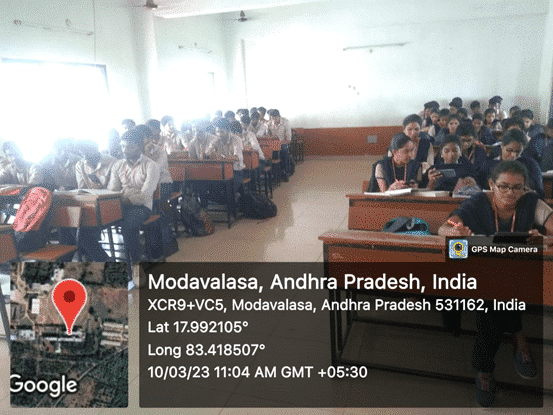
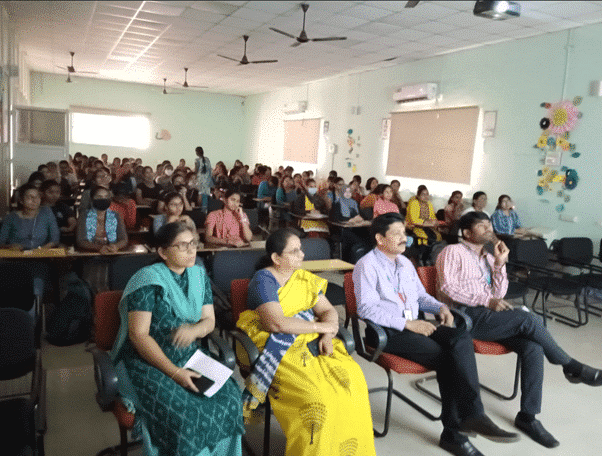
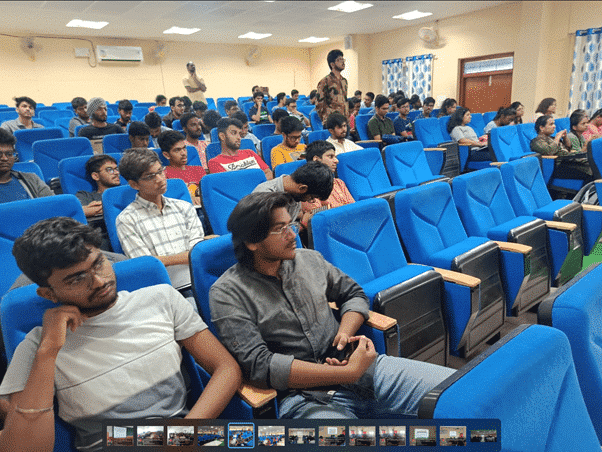
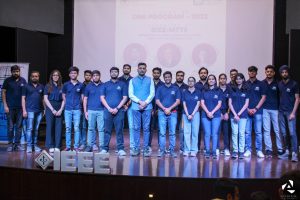
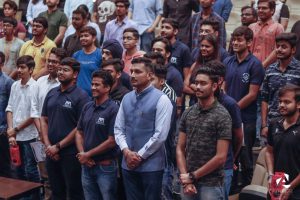
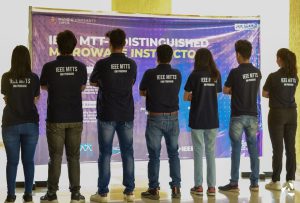
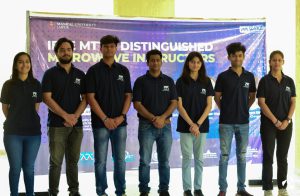
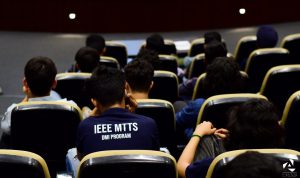
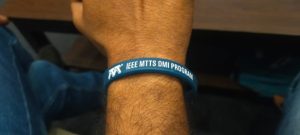
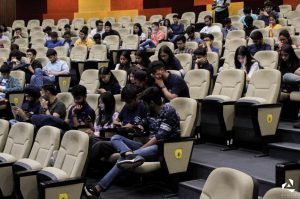

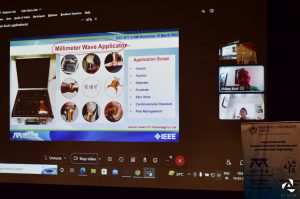
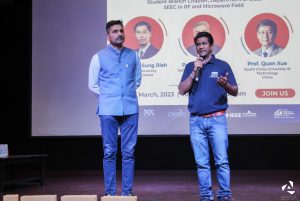
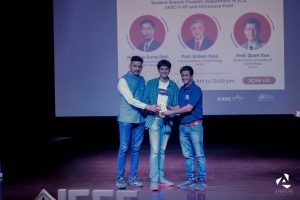


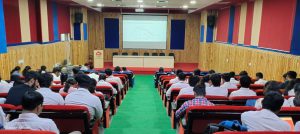
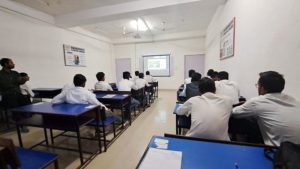
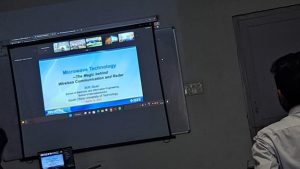
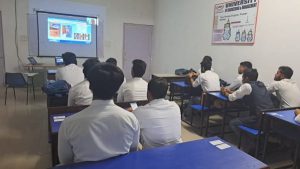
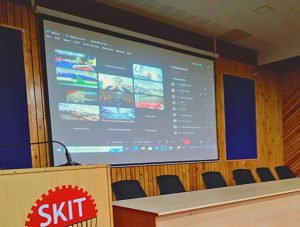
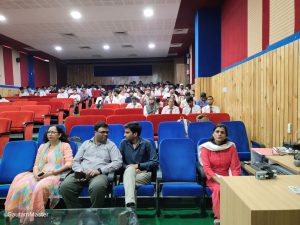
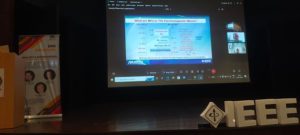
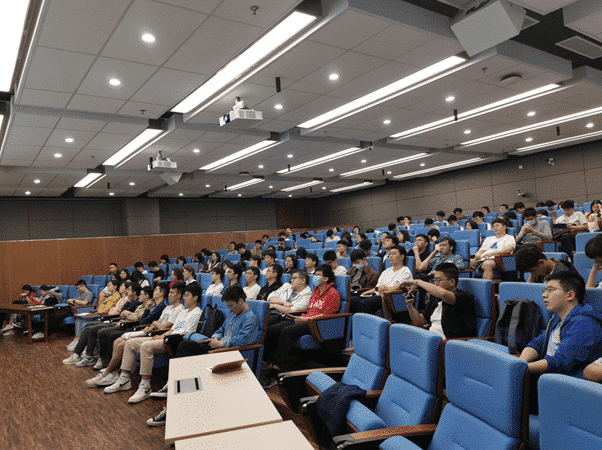

Topics discussed during Q & A session:
- from Sun Yat-sen University to everyone: 4:57 PM
- Thank you for your wonderful sharing today. For beginners in microwave related fields like me who want to find interesting and promising directions faster, we want to know that how do you maintain your sensitivity to cutting-edge fields and find suitable research directions?
- from SCUT_GZIC to everyone: 4:58 PM
- Hi Prof. Rieh, THz applications maybe still in research now, so when do you think those applications will come into our life?
- from Vartika to everyone: 4:58 PM
- Sir Please tell us more about Smart Tattoo Antenna
- from SCUT_GZIC to everyone: 4:58 PM
- Hi Prof. Koul, Does the flatness of the skin area where the smart tattoo antenna covers affect the antenna’s performance?
- from SCUT_GZIC to everyone: 4:59 PM
- Hi Prof. Xue, How do you rate the Space X Starlink Gen 2 which is launched recently and works in E-band?
- from SCUT_GZIC to everyone: 5:02 PM
- Hi Prof. Xue, you show us the antenna and chip, so how do you think of antenna on chip?
- from MUJ to everyone: 5:02 PM
- Koul what are the internship/project opportunities available for the under graduate students
- from prerana reddy to everyone: 5:02 PM
- Hi prof.koul,will smart tattoo effect our body ?
- from MUJ to everyone: 5:02 PM
- Manipal University Jaipur;
- from B60 Bhavya T to everyone: 5:03 PM
- Koul what are the internship/project opportunities available for the under graduate students . please answer this
- from Dr Sumi M to everyone: 5:04 PM
- what are the possible bodily effects of ingest or endoscopic capsules?
- from Vartika to everyone: 5:04 PM
- Which is the best implantable antenna for human body?
- from Dr Sumi M to everyone: 5:04 PM
- How endoscope capsules are externally controlled?
- from Athul Asok to everyone: 5:04 PM
- Hi Prof Koul sir….does the other parameters in blood effect the glucose level monitoring using RF
- from prerana reddy to everyone: 5:05 PM
- how will endoscopic capsule function in human body??
- from MUJ to everyone: 5:05 PM
- Manipal University Jaipur : Panelists , could you please tell as to how precise is the gadget versions for medical treatments as compared to the already existing technologies present in the hospitals.
- from Dr Sumi M to everyone: 5:05 PM
- Could you explain the working of multichannel doplar radar?
- from vikas kumar to everyone: 5:06 PM
- is terahrtz frequency range harmuful for human beigns?? i mean by any means of radiations ..
- from Dr Sumi M to everyone: 5:07 PM
- Can you give more details about fire radar?
- from Deepak Yadav to everyone: 5:07 PM
- Koul, i read that skin depth decreases as we move to higher frequencies. Considering this, how effective would it be to use THz frequencies in biomedical antenna/sensors?
- from SHUBHI JAIN (privately): 5:07 PM
- how these microwave technology evoluting these days are able to replace these expensive surgical methods of the removing the cancer
- from Dr Sumi M to everyone: 5:08 PM
- What are the bodily effects of microwave fat reduction?
- from Dr Sumi M to everyone: 5:09 PM
- Are there any developments in RF based smell sensors?
- from Arun Muthu Ram M to everyone: 5:11 PM
- How is the issue of scattering of EM waves overcome in THz range?
- from Gangula Acharya to everyone: 5:13 PM
- are there any job opportunities for antenna designers?and can you suggest the possible ways to evolve as antenna designer
- from Gorre Srikanth to everyone: 5:13 PM
- sir do we have any summer schools in these summers in universities and colleges?
- from prerana reddy to everyone: 5:13 PM
- will there be any internships and workshops in coming days for ous to apply?
- from vikas kumar to everyone: 5:15 PM
- with these millimetre waves can we remove the tumour with out any surgery
- from Dr Sumi M to everyone: 5:15 PM
- Prof Xue, Could you tell more regarding fire control radar?
- from DEBAJIT SARMA to everyone: 5:15 PM
- Hi Professor Koul….what is the usual power level, noise figure for the THz sensors?
- from vikas kumar to everyone: 5:15 PM
- Do we have any summer school programs
- from Athul Asok to everyone: 5:15 PM
- Hi Prof. Rieh. Can you please explain the distance between the transducer and the chocolate in the case of terahertz imaging? Also please explain the image reconstruction process.
- from Gorre Srikanth to everyone: 5:16 PM
- sir can we get international explosure for learning new technologies in antennas?
- from Arun Muthu Ram M to everyone: 5:16 PM
- Hi Prof Rieh. While scaling down the transistors, will the parasitic delays affect the operation at high frequency? If so how can we mitigate it…
- from Dr Sumi M to everyone: 5:18 PM
- Prof Rieh, As a result of progress in antenna array and technology with advancement of transistors is there any chance of reducing the size of geostationary satellites in near future
- from Dr Sumi M to everyone: 5:19 PM
- What will be the efect of advanced microwave technology in cosmic microwave backgroud studies?
- from DEBAJIT SARMA to everyone: 5:19 PM
- Hi Professors, THz generation in the laboratory environment is costly. Then how we can manufacture THz sensors/devices on low cost?
- from Dr Sumi M to everyone: 5:21 PM
- Prof Xue , Could you elaborate more about automotive radars and its effects on our daily lives?
- from vikas kumar to everyone: 5:21 PM
- with these millimetre waves can we remove the tumour with out any surgery
- from vikas kumar to everyone: 5:21 PM
- with these millimetre waves can we remove the tumour with out any surgery
- from Athul Asok to everyone: 5:22 PM
- Hi Prof. Rieh. What was the power of the transmitted signal in the imaging experiment?
- from KARJI RIHANA BEGUM to everyone: 5:25 PM
- what will be the future scope of RF engineer
Screen shot before closing:
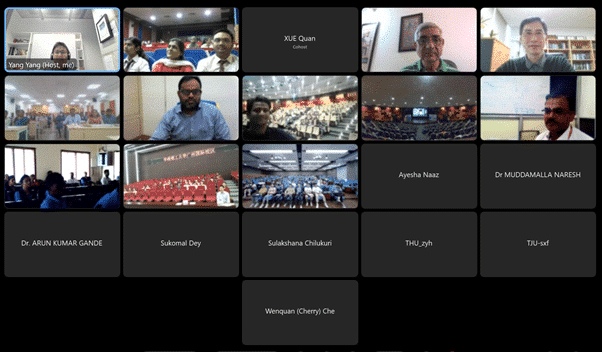
The 5th IEEE MTT-S DMI Workshop
Date: 04 May 2023 12:00pm (Central Europe Time, Berlin/Madrid/Paris/Rome)
Region: 8
Venue: WebEx and countries in Europe.
DMI Speakers: Prof. Jasmin Grosinger, Prof. Jae-Sung Rieh and Prof. Shiban Koul

The scope of the talks:
The DMIs introduced the history of microwave and radio frequency technologies, the evolution of modern microwave systems, and the cutting-edge wireless applications yet to be used in our daily lives in the foreseeable future. The DMIs presented the long journey of wireless technologies from traditional applications 30 years ago (radio, TV and analog mobile phone) to today’s portable devices and wearable/implantable wireless sensors, all relying on microwave technologies. The DMIs discussed three topics in this workshop: Radio Frequency Designs for Sustainability, Electronics in Extreme Frequencies and Electromagnetics for Healthcare.
Attendance (on campus):
Germany:
- Ruhr-University Bochum, Germany
- Faculty Advisors: Dr.-Ing. Jan Barowski, Prof. Dr.-Ing. Ilona Rolfes
- The number of students in classroom: 48
France: through IEEE Student Branch – Université Grenoble Alpes
- University of Grenoble Alpes
- Faculty Advisors: NGUYEN Nhu Huan
- The number of students in classroom: 12
Spain:
- Universidad Politecnica de Cartagena, Spain
- Faculty Advisors: Alejandro Alvarez Melcon
- The number of students in classroom: 12
Austria:
- Graz University of Technology, Austria
- Faculty Advisors: Reinhard Teschl
- The number of students in classroom: 5
Attendance (online): 147, see attendees’ details in Appendix 2.
Total estimated attendees: 224
Survey by attendees:
- Jacques Brits: Overall very interesting
- Hugo: I enjoyed the talks and being kept up to date on recent developments in the RF engineering industry.
- Savannah Bennett: It was interesting
- Kaizer: Very interesting. All presentations were succinct and presented with care. I look forward to the next one
- Özlem Aydin Civi: It is useful for the students to see the possibilites of research directions in Microwave area.It is a ptity that there are only a few questions from the students. It would be good to find ways of encouraging students to ask questions
DMI Organising Committee:
Yang Yang, Ilona Rolfes, Zlatica Marinkovic, Miguel A. G. Laso
Advisors: Xun Gong, Wenquan Che, Ke Wu, Shiban Koul
On-Campus organisers: Jan Barowski, Ilona Rolfes, Nguyen Nhu Huan, Alejandro Alvarez Melcon, and Reinhard Teschl
Region 8 Ambassadors: See Appendix 3
Agenda:
- 11:30 am – 12:00 pm – Workshop Preparation. The DMIs, ambassadors and moderators (faculty members) log in to the Webex system. Arrange the students to settle down in the classrooms.
- 12:00 pm – 12:05 pm – Opening (Brief introduction to DMI program, (approximately 3 min) by Prof. Ilona Rolfes.
- 12:05 pm – 12:25 pm (about 20 min) – Presentation by Prof. Jasmin Grosinger (Graz University of Technology)
- 12:25 pm – 12:45 pm (about 20 min) – Presentation by Prof. Jae-Sung Rieh (Korea University, South Korea)
- 12:45 pm – 1:05 pm (about 20 min) – Presentation by Prof. Shiban Koul (Indian Institute of Technology, India)
- 1:05 pm – 1:45 pm (about 30 min – 40 min) – Q & A in (questions posted in Chat window)
- 1:45 pm – 2:00 pm Closing (Photo taken for all through Webex) by Prof. Zlatica Marinovic
The moment:
- The opening by Ilona Rolfes – 5 min
- Overview of the DMI workshop
- Agenda
- What is DMI
- Why we have DMI workshop
- Introducing the DMI speakers
- The Talk by Jasmin Grosinger:
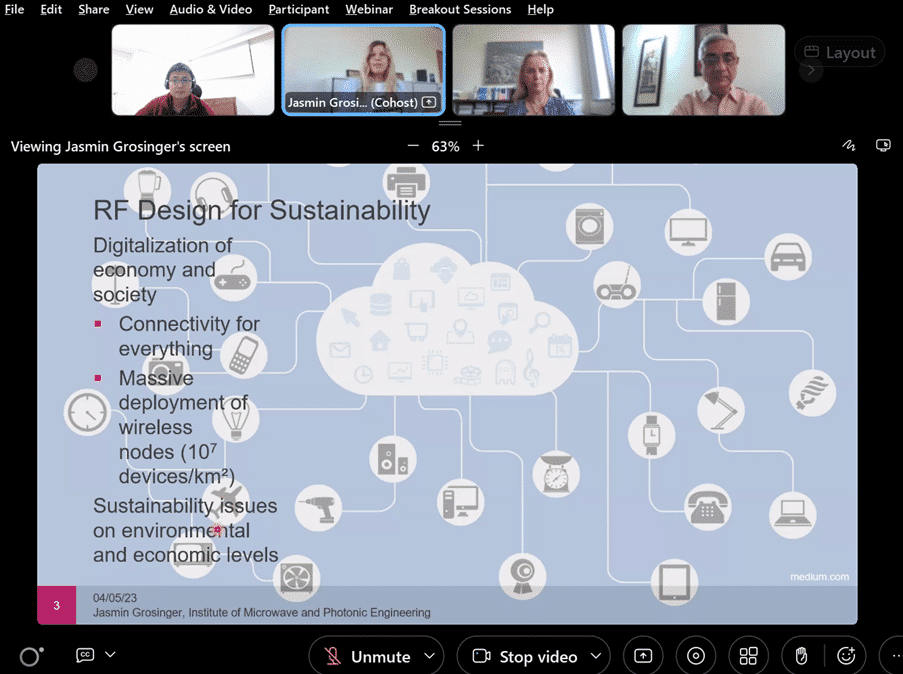
- The Talk by Jae-Sung Rieh:
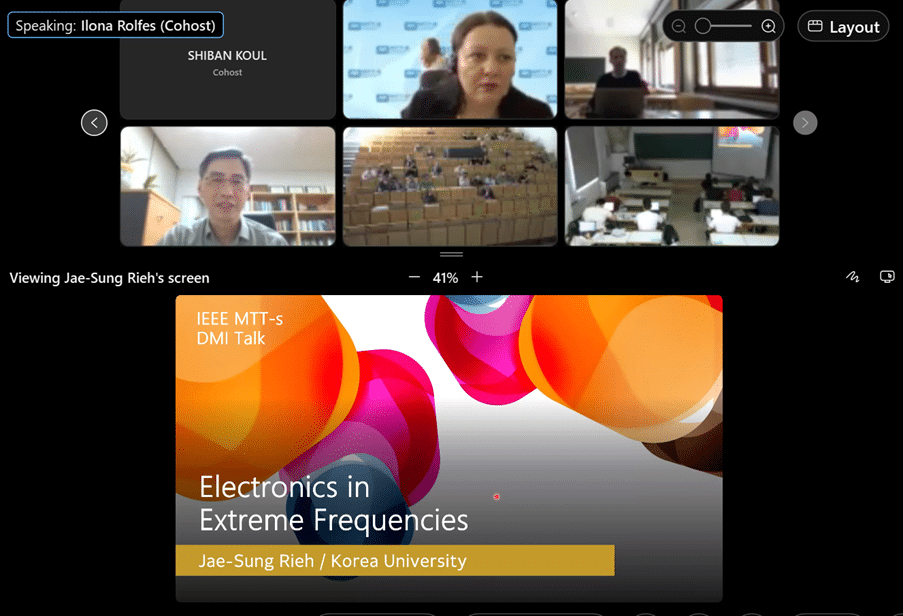
- The Talk by Shiban Koul:
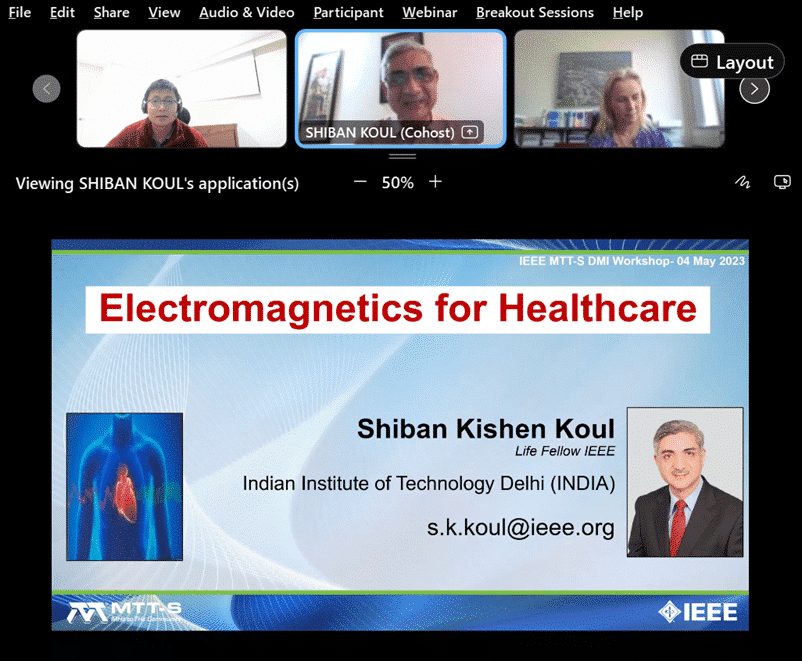
- Promotion of MTT-S Undergraduate Scholarship and Postgraduate Fellowship by Zlatica Marinkovic:
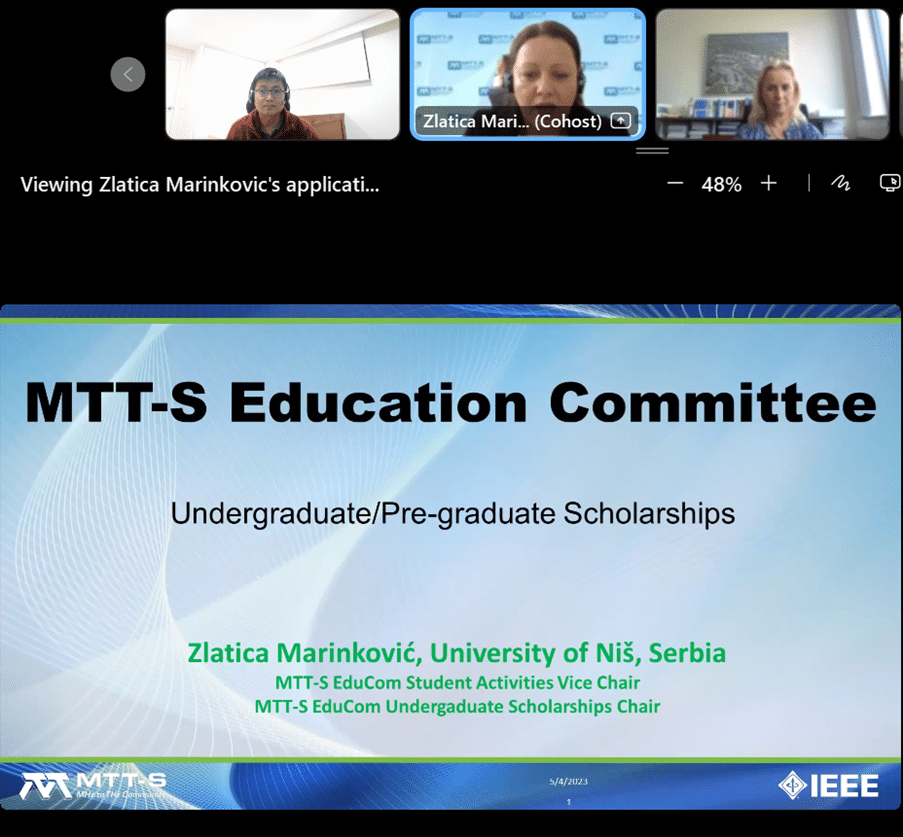
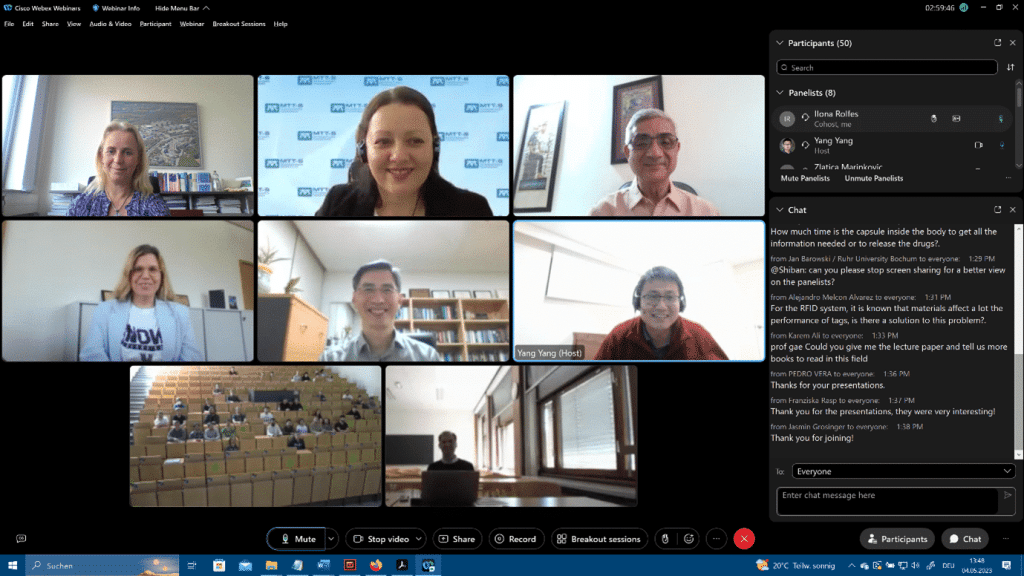
Appendix 1 – Questions discussion among the students and DMIs:
- from Soham Lakhote to everyone: 8:48 PM
In slide 20, why III/V HBT has fT around 700GHz but fMAX of only 200GHZ? Shouldn’t fT and fMAX increase together?
- from Soham Lakhote to everyone: 8:52 PM
In slide 25, any reason for using the the Mixer first architecture? Why not use LNA as the first block?
- from Thi-Hong-Le Dam to everyone: 8:53 PM
Can you provide please a comparison based on the minimal noise of these technologies?
- from Soham Lakhote to everyone: 8:56 PM
Prof, how did you characterize the chip to package interface at such a high frequency? Or did you directly probe the chip pads while doing the imaging experiment?
- from Alejandro Melcon Alvarez to everyone: 9:29 PM
How much time is the capsule inside the body to get all the information needed or to release the drugs?.
- from Alejandro Melcon Alvarez to everyone: 9:31 PM
For the RFID system, it is known that materials affect a lot the performance of tags, is there a solution to this problem?.
- from Karem Ali to everyone: 9:33 PM
prof gae Could you give me the lecture paper and tell us more books to read in this field
Appendix 2: Attendees
| Marios Joannou | University of Pretoria |
| Biljana Stošić | Faculty of Electronic Engineering, University of Niš |
| Hugo | University of Pretoria |
| Marija Milijić | University of Nis |
| Dan Li | University of Birmingham |
| Master Telecom Tech. Univ. Cartagena | Technical University Cartagena |
| Pallab Gogoi | TU Delft |
| Ksenija Pesic | University of Nis |
| Somia Sharma | IIT Delhi |
| Dino De Sousa | University of Pretoria |
| Jose Romero Lopera | Graz University of Technology |
| Werner Wiesbeck | Karlsruhe Institut of Technology |
| milica | elektronski fakultet |
| Toplica | Elektronski fakultet Nis |
| Aleksandar Atanaskovic | Faculty of Electronic Engineering, University of Niš |
| LEOKADIA NDJULUWA | University of Namibia |
| Ankia Fuls | University of Pretoria |
| Jacques Brits | University of Pretoria |
| Johan van Niekerk | University of Pretoria |
| Leard Prenzler | University of Pretoria |
| Natasa Males-Ilic | Faculty of electronic engineering |
| Hsu Ting-Li IFAG PSS RFS D1 RF ANT | Infineon |
| Jelena Dinkic | School of Electrical Engineering |
| Tingyu Qiu | University of Birmingham |
| Arturs Aboltins | RTU |
| Husna Moosa | University of Pretoria |
| Ratul | IIT Delhi |
| Evagelia Nichas | University of Pretoria |
| Byron Moore | University of Pretoria |
| Franziska Rasp | OTH Regensburg |
| Jacques Nortje | University of Pretoria |
| Binh Pham | Universität Ulm |
| Savannah Bennett | University of Pretoria |
| Yuhao Zheng | university of Birmingham |
| 2537 428 1307 | NTU Singapore |
| Jugoslav Jokovic | University of Nis, Faculty of Electronic Engineering |
| Keshin Bheema | University of Pretoria |
| Sedighi Afsaneh | Babol Noshirvani University of Technology (BNUT) |
| PEDRO VERA | IES Ingeniero de la Cierva |
| Reaoleboga | UP |
| Mohamed Ghatas | INESCTEC |
| Natalie | University of Pretoria |
| RJ Botes | University of Pretoria |
| Tinosimuka Ndava | University of Pretoria |
| Abdullah Al Kafi | University of Hertfordshire |
| Brendon de Beer | University of Pretoria |
| Neil Marais | University of Pretoria |
| Renate Krause | University of Pretoria |
| TAHMASEBI | IUT |
| Ruan Peyper | TUKS |
| Zoran Stankovic | University of Nis, Faculty of Electronic Engineering |
| Thabiso Maisela | University of pretoria |
| Karem Ali | Zagizag university Faculty of engineering |
| Majede | Babol Noshirvani University of Technology |
| Hanru Jansen Van Rensburg | University of Pretoria |
| Kaizer | Nerospec |
| Ali Mohammadi | University of Bath |
| Mina | Faculty od technical sciences |
| MADAN KUMAR SHARMA | University of Buraimi |
| IMS Laboratory | IMS Laboratory |
| Thi-Hong-Le Dam | IMEP-LaHC |
| Mohammad-Ali Damavandi | Iran university of science and technology |
| Plamedi Luis | University of Pretoria |
| Ntokozo Mthembu | university of pretoia |
| Stefan Corcodel | Bayanat |
| P Mendes | Univ. Minho |
| Keano Geldenhuys | University of Pretoria |
| Zenzele Xaba | University of pretoria |
| Hasan Abo Seida | Egyptian Space Agency |
| Özlem Aydin Civi | Middle East Technical University |
| Kimberly Mpala | University of Pretoria |
| Djalal eddine Bensaid | University of Batna 2 |
| Kristiyan Petkov | Student |
| Jovana Nesic | Elektronski Fakultet Nis |
| Eugene Ogbodo | University of Hertfordshire |
| rAHUL | Nokia |
| Nikola | Faculty of Technical Sciences |
| Plamedi Luis | University of Pretoria |
| Samuel Ukpe | University of Pretoria |
| Nikola | Faculty of Technical Sciences |
| Zenzele Xaba | University of pretoria |
| Ali E | Iran |
| Tlhabanelo Manzini | University of Pretoria |
| Abolfazl Ebrahimnejad | GOLESTAN Telecommunication |
| pascal xavier | IMEP-LaHC |
| Armando | FEUP |
| Soham Lakhote | IISC Banglore |
| Zhen Luo | TU Munich |
| Master Teleco UPCT | Technical University Cartagena |
| Nebojsa Doncov | Faculty of Electronic Engineering, University of Nis |
| Reza Khajeh Mohammad Lou | Islamic Azad University |
| Mohammad Alizadegam | University of Kashan |
| Arian Tahmasebi | IUT |
| Fanlin MENG | fau |
| MetaRadiator | Khon Kaen Univerdity |
| Abdullah Al Kafi | University of Hertfordshire |
| Abdullah Ghoor | Tuks |
| Nikola | Faculty of Technical Sciences |
| Alejandro Melcon Alvarez | Technical University Cartagena |
| Mina | Faculty od technical sciences |
| Luanre van Niekerk | University of Pretoria |
| Plamedi Luis | University of Pretoria |
| Hanru Jansen Van Rensburg | University of Pretoria |
| Parinaz Binandeh Dehaghani | FEUP |
| Fanlin MENG | fau |
| Kimberly Mpala | University of Pretoria |
| Reaoleboga Legodu | UP |
| rAHUL | Nokia |
| MADAN KUMAR SHARMA | University of Buraimi |
| Renate Krause | University of Pretoria |
| Shelly Cazalet | University of Pretoria |
| Reinhard Teschl, TU Graz | Graz University of Technology |
| Jade | University of Pretoria |
| Jan Barowski | |
| Reinhard Teschl, TU Graz | Graz University of Technology |
| Anthea | University of Pretoria |
| Armando | FEUP |
| Thi-Hong-Le Dam | IMEP-LaHC |
| Abbas movahednia | Shahroud |
| Dusan Nesic | Centre of Microelectronic Technologies, A Division of the Institute of Chemistry, Technology and Metallurgy |
| Jan Barowski | |
| Reza Khajeh Mohammad Lou | Islamic Azad University |
| Yuhao Zheng | university of Birmingham |
| Jelena Dinkic | School of Electrical Engineering |
| Majede | Babol Noshirvani University of Technology |
| Pedram Sohrabi | Semnan university |
| Plamedi Luis | University of Pretoria |
| Alejandro Melcon Alvarez | Technical University Cartagena |
| Mohamed Ghatas | INESCTEC |
| Pedram Sohrabi | Semnan university |
| Jovana Nesic | Elektronski Fakultet Nis |
| Nikola | Faculty of Technical Sciences |
| PEDRO VERA | IES Ingeniero de la Cierva |
| Reinhard Teschl, TU Graz | Graz University of Technology |
| Reinhard Teschl, TU Graz | Graz University of Technology |
| Yuhao Zheng | university of Birmingham |
| Yusuf Deniz Tandogan | Istanbul Technical University |
Appendix 3: List of DMI Ambassadors in Region 8
| Name | Country | University |
| Reinhard Teschl | Austria | TU Graz |
| Ali Darwish | Egypt | American Univ in Cairo |
| Stephane Bila | France | Limoges/Xlim |
| Nicolas Delhote | France | Limoges/Xlim |
| Aurelian Crunteanu | France | Limoges/Xlim |
| Anthony Ghiotto | France | Bordeaux |
| Michael Höft | Germany | Kiel University |
| Nils Pohl | Germany | Ruhr University Bochum |
| Ilona Rolfes | Germany | Ruhr University Bochum |
| Vahid Nayyeri | Iran | Iran Univ. Science and Technology |
| Dimitra Psychogiou | Ireland | Tyndal National Institute |
| Pino Macchiarella | Italy | Politecnico di Milano |
| Cristiano Tomassoni | Italy | Univ. Perugia |
| Mohamed Essaaidi | Morocco | Mohammed V University |
| Michal Mrozowski | Poland | Gdansk University |
| Adam Lamecki | Poland | Gdansk University |
| Nuno Carvalho | Portugal | University of Aveiro |
| Zlatica Marinkovic | Serbia + Montenegro + Bosnia & Herzegovina + North Macedonia + Bulgaria | University of Niš |
| Tinus Stander | South Africa | University of Pretoria |
| Miguel Laso | Spain | UPNA |
| Roberto Gómez García | Spain | Univ. Alcalá |
| Christian Fager | Sweden | Chalmers |
| Yi Wang | UK | Univ. of Birmingam |
| Nikolaos Uzunoglu | Greece | National Technical University of Athens |
| Tibor Berceli | Hungary | Budapest University of Technology and Economics |
| Siddik Yarman | Turkey | Istanbul Technical University |
| Nazih Khaddaj Mallat | United Arab Emirates | Al Ain University |
Appendix 4: Photos from the classes

